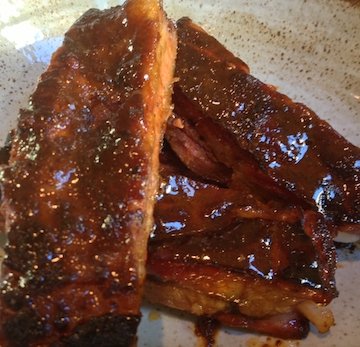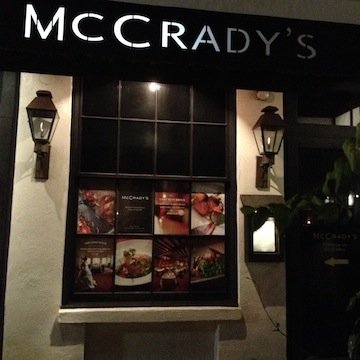(read part one)
I was impressed by Sean Brock because he has created two establishments with a very different offer but sharing the same philosophy and the same suppliers and products, only a short walk apart, in the historic centre of Charleston, South Carolina. He’s certainly not the first chef to manage two distinct restaurants, especially not in the United States. Except he hasn’t created, say, a gourmet place and a pizzeria or a Mexican restaurant, two completely different things, that is. He’s grown evolving along the line that he himself had began to trace, with a strong link with the territory in which he lives and in a way even that in which he was born, since Virginia is not that far away, just two states to the North.

Tomato salad with tomato sauce emulsion and olive oil at Husk Restaurant brunch. Extravirgin oil is a Texas product
It’s true, everywhere you go, it is now fashionable to magnify one’s miraculous kitchen garden, the best of the local products and history while bringing everything to the future. Sean does this well because he’s not improvising. Five years ago, for instance, after returning to Charleston to work and live, he bought a farm in Wadmalaw, which is more of a lagoon than a true island, with two and a half hectares where he recuperates and cultivates ancient seeds(for North American standards), which were dear to the native people before the Civil War - after the defeat, closed an era.
I stress this because it is obvious that
Sean would prepare some superb spare ribs even at my place in Milan, but when a chef buys his grocery locally (and not on the phone) encouraging other producers to take the road of quality, you would penalise him by removing from his origins.

Super pork ribs, slowly smoked with pecan nuts' shells at Husk BBQ. Pure poetry
The first stop, last Saturday, September 28th, was at
McCrady’s, named after
Edward McCrady,who in 1778 opened here, in the centre, a tavern and 13 years later hosted a party with 30 courses for president
George Washington. It closed down, later on, and the building was renovated in 1982 and today is listed among the United States’ historical places. The food, however, is far away from being dusty.
Brock’s secret is knowing how to make his world contemporary, even by personally interpreting the 19th centurySouthern recipe books he collects. The aim is to make everything a part of the whole.
At
McCrady’s there’s a menu and a tasting menu, and there’s a list with all the suppliers too. The journey is marked, for instance, by Prawns and butternut squash, Smoked trout with crispy skin, Charleston Ice Cream, a sort of rice pudding, with rice that has been matured for three years, up to the lamb, first, and then the beef ribeye with chanterelle mushrooms and finally to the dessert. Matched with this food we were served
Ama 2009, a Pinot Noir produced by
Peay on the Sonoma Coast, in California, so intense, rich in perfumes and drinkable it didn’t seem American.
On Sunday it was the turn of brunch, not the buffet one, half breakfast, half lunch, a little sweet and a little savoury that we’ve all come accustomed to. Brunch at
Husk Restaurant reminds one of Italian Sunday lunch. You sit in a two-floor Victorian, late 19th century house, renovated with a minimalist approach, and you can order from the menu or trust the chef. There is no tasting menu unless you decide to give total freedom to the kitchen, which was my choice. And a delicious one.

The entrance of McCrady's on East Bay Street, downtown Charleston. The 'real' entrance is in side little street, Unity Valley, number 2
Please forgive my frankness when I say that this lunch coincided with the new trends in contemporary cuisine: wisdom, taste, richness, territory, genius, variety (even in the glass, from cider to beer to bourbon), and price. And even though this would be
Brock’s second restaurant (it basically costs half as much as
McCrady’s, 35 dollars versus 65, excluding taxes, service and drinks) I found a higher final value here because the kitchen has more freedom. Bound by the fact it is set in an important place, a historical one for Charleston,
Husk has the advantage of a measured informality. And what delicious dishes: Spicy quail eggs; Oysters marinated with berries and in the oven and soaked in Bloody Mary (truly sensual); Tomato salad (we’re not the only ones capable of making this dish stand out); some touching Prawns with pop corn cream, intense Pork ribs finished with the smoke of the pecan nuts shells. Unfortunately, only one each. So I have at least 9 reasons to go back to
Husk. Ten, in fact, it the minimum number of pork ribs served daily.
2. The end